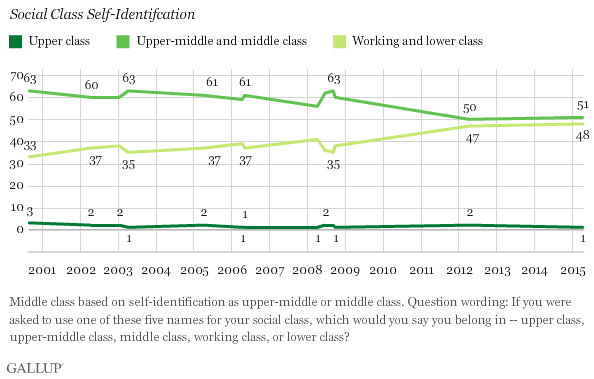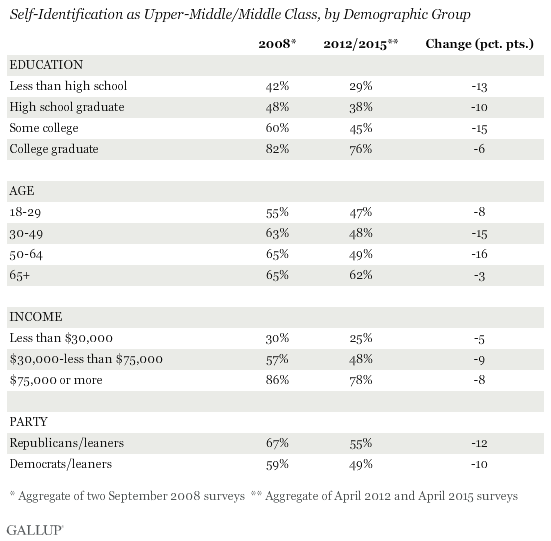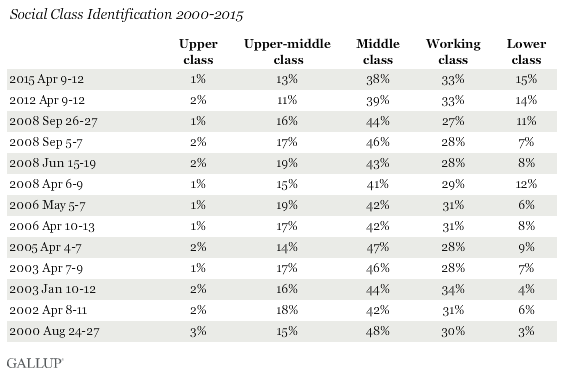Fewer Americans Identify as Middle Class in Recent Years
Wednesday, May 6th, 2015
Americans are considerably less likely now than they were in 2008 and years prior to identify themselves as middle class or upper-middle class, while the percentage putting themselves in the working or lower class has risen. Currently, 51% of Americans say they are middle class or upper-middle class, while 48% say they are lower class or working class. In multiple surveys conducted from 2000 through 2008, an average of more than 60% of Americans identified as middle or upper-middle class.

Gallup began asking this five-part social class question in 2000. In that year, and at several points since, a high of 63% of Americans identified as either upper-middle or middle class. The average percentage placing themselves in the two middle-class categories between 2000 and 2008 was 61%.
Gallup didn't ask the question between 2009 and 2011, but in 2012 and again this year, the combined middle-class percentage dropped significantly, to 50% and 51%, respectively. On the other hand, the percentage of Americans identifying as working and lower class rose to 47% and 48%, up from a low of 33% in 2000.
There are many ways researchers measure subjective social class. This particular question gives Americans five categories from which to choose. Just 1% of Americans say they are upper class, with the rest spread out in Gallup's April 9-12 survey across upper-middle (13%), middle (38%), working (33%) and lower (15%) class categories. The detailed trends are displayed at the end of this article. Questions which ask respondents to choose only between upper, middle and lower class categories find a larger percentage in the middle-class category than is the case with the five-category measure.
Across all major demographic and political subgroups, identification as middle class or upper-middle class has declined since 2008. In particular, the drop in middle-/upper-middle-class identification by income category has been fairly consistent, between five and nine percentage points in each income group. Overall, even as middle-class identification has dropped across the board, Americans' views of their social class have remained closely tied to their income, as would be expected.

Middle-class identification among those with college degrees has dropped less than it has among those with less education, and older and younger Americans have seen less change in their identification with the middle or upper-middle class than Americans between the ages of 30 and 64. Republicans are more likely to identify as middle class than Democrats, but both groups have seen roughly even drops in identification with the middle class across time.
Implications
Americans have become less likely to identify as middle class since 2008 and earlier years. One possible explanation focuses on changes in the job market. A big downshift in middle-class identification is found among those with less than a college education, suggesting that increasingly fewer "middle-class" jobs may be available for those without college educations. Further, middle-class identification dropped the most among Americans in their middle-age years, showing that the shifting economy and job market may be most likely to affect the class perceptions of those who are more anchored in their careers, rather than those just starting out or those who are at or near retirement. Similar changes among Republicans and Democrats suggest that politics has not been a major factor in the shift in self-identified class labels.
The percentage identifying as middle or upper-middle class was almost the same in 2012 as it is in 2015, even though the economy, at least as perceived by the public, is in much better shape now than it was in 2012. This could suggest that Americans have shifted into a "new normal" way of looking at their class standing, with the Great Recession having convinced a number of Americans that they are not now, nor are they going to be, middle class -- but rather are firmly ensconced in either the working or lower class.
The term "middle class" still resonates with politicians, many of whom are certainly not hesitant to use it to describe those voters their policies are designed to benefit. An exception, however, has been newly announced presidential candidate Hillary Clinton. In her announcement video, she used the term "everyday Americans" to describe her target market, eschewing, at least for the moment, the term middle class. As she proclaims on the front page of her campaign webpage: "Everyday Americans need a champion. I want to be that champion." Perhaps Clinton and her strategists are aware that fewer Americans these days see themselves as middle class, prompting the use of more inclusive terminology in their campaign rhetoric.



